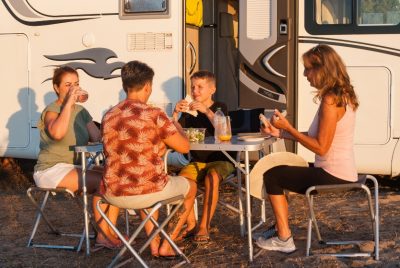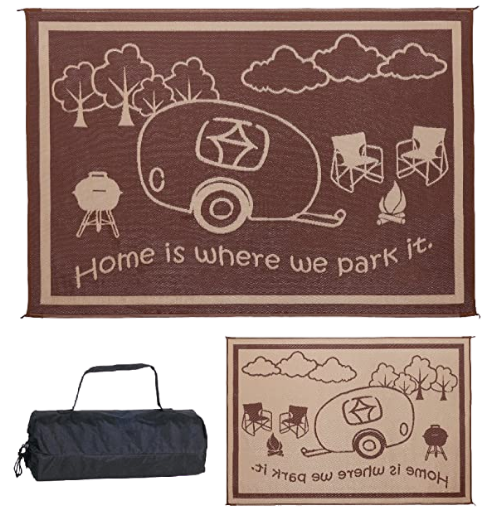Traveling in an RV can be the adventure of a lifetime, but the costs can quickly…
13 Tips To Plan Your First National Park RV Trip

There’s something magical about hitting the open road in an RV, watching the landscape change as you get closer to a national park.
The freedom to explore, the thrill of discovery, and the simple joy of waking up surrounded by nature make RV travel a unique experience.
But planning your first national park RV trip can feel overwhelming—there’s a lot to juggle: campsite reservations, park rules, RV maintenance, gear, and all the little details that make a trip smooth and enjoyable.
If you’re ready to embrace adventure but want to make sure your first trip is stress-free, these 13 tips will guide you through RV national park planning from start to finish.
By the time you’re done, you’ll feel confident, prepared, and excited to hit the road.
1)) Choose the Right National Park
Picking the perfect national park for your first RV adventure sets the tone for your trip.
Some parks are more RV-friendly than others. Consider the size of your RV and your comfort level with driving larger vehicles.
Parks with narrow roads, steep inclines, or tight campsites may be challenging for beginners.
Think about what kind of experience you want: Do you want scenic drives, wildlife spotting, hiking, or a mix of everything? Look at parks with easily accessible viewpoints, well-equipped campgrounds, and a variety of activities.
Some of the most beginner-friendly options include Yellowstone, Grand Canyon, Yosemite, and Great Smoky Mountains.
Pro Tip: If this is your first time, consider a park within a few hours of home. It allows you to test your RV skills without committing to a long, stressful drive.
2)) Plan Your Route Carefully
Once you’ve picked a park, the next step is route planning. Driving an RV is different from driving a car.
It requires more space, slower speeds, and extra attention. Map your route carefully and look for RV-friendly roads.
Avoid narrow mountain roads, low-clearance bridges, and steep inclines if you’re uncomfortable with them.
Check for fuel stops, RV parks along the way, and dump stations. Some parks are remote, so knowing where services are located can save a lot of stress.
GPS apps designed for RV travel can help you avoid tricky roads and build confidence on the highway.
The journey is part of the adventure. Scenic detours, small towns, and roadside attractions can make your road trip memorable. Just make sure you plan enough time so that driving doesn’t feel rushed or overwhelming.
3)) Make Your Campsite Reservations Early
National parks are popular, and campsites fill up quickly. Making reservations early is critical, especially during peak season. Many parks allow reservations up to six months in advance, and some fill in minutes.
Consider the type of campsite that suits your RV and preferences:
- Full Hookup: Water, electricity, and sewer connections. Ideal for first-timers or those who want convenience.
- Partial Hookup: Water and electricity, but no sewer. A good balance between comfort and flexibility.
- Boondocking or Primitive Sites: No hookups. Perfect for those who want to embrace the outdoors, but it requires preparation.
Location matters too. Choose campsites close to the trails, scenic viewpoints, or park entrances you want to visit. Being strategic about your campsite can save driving time and enhance your experience.
4)) Prepare Your RV Thoroughly
Nothing can derail a trip faster than an unprepared RV. Before leaving, thoroughly inspect your vehicle.
Check tire pressure, brakes, fluids, lights, and all major systems. Make sure your propane tanks are full and your batteries are charged.
Familiarize yourself with all the systems in your RV: water, sewer, leveling jacks, generator, and electrical panels.
If you’re renting, don’t hesitate to ask for a full walkthrough—most rental companies are happy to show first-timers the ropes.
A pre-trip checklist can save headaches. Include items like hoses, sewer connections, leveling blocks, extension cords, and basic tools.
Think of this as your safety net—if anything goes wrong, you’ll be prepared.
5)) Pack Smart and Light
Packing for an RV trip is a balancing act. You need enough gear to be comfortable, but overpacking can make your RV feel cluttered and harder to manage.
Focus on essentials:
- Bedding, towels, and clothing suitable for changing weather.
- Cooking supplies: pots, pans, utensils, and small appliances, if needed.
- Food and snacks for easy meals on the road.
- Park essentials: maps, guidebooks, binoculars, sunscreen, and insect repellent.
Leave room for souvenirs, firewood, or any gear you might pick up along the way. Remember, the RV is both your transportation and your home—organization is key.
6)) Learn the Park Rules and Regulations
Each national park has its own rules, and RVers must respect them. Some parks restrict RV sizes on certain roads or in certain campgrounds. Others have quiet hours, fire regulations, or generator restrictions.
Wildlife safety is crucial. Never approach animals, and always store food properly.
Many parks have bear-proof containers or lockers—use them. Also, practice Leave No Trace principles to minimize your impact on the environment.
Understanding the rules ahead of time helps you enjoy the park without fines or unpleasant surprises.
7)) Plan Your Activities in Advance
While spontaneity is part of the fun, a little planning ensures you don’t miss out on the park’s highlights.
Research hikes, scenic drives, and attractions you want to see. Check trail difficulty, estimated time, and any seasonal considerations.
Make sure you leave time for flexibility. Some of the best moments come from unplanned discoveries—a hidden waterfall, a wildlife sighting, or a peaceful sunrise spot.
Pro Tip: Many parks have visitor centers or ranger programs that offer guided tours, talks, or night sky programs.
These are great for first-time visitors and often provide insider tips you won’t find online.
8)) Budget Wisely
RV travel can be economical or pricey, depending on planning. Budget for:
- Campsite fees: $20–$60+ per night, depending on hookups and popularity.
- Park entrance fees: Usually $30–$35 per vehicle for a 7-day pass.
- Fuel: RVs are heavy on gas, especially larger models.
- Food, gear, and any guided activities.
It helps to plan a buffer for unexpected expenses. Fuel stops, last-minute supplies, or park extras can add up quickly.
9)) Safety First
Driving, camping, and exploring all come with safety considerations. Always drive slower than normal, especially on winding roads or unfamiliar terrain. Use mirrors and backup cameras when parking.
Keep a first aid kit, roadside emergency kit, and fire extinguisher accessible. Know where emergency services are located within the park.
Also, check the weather before leaving—conditions can change rapidly in many parks, especially at higher elevations.
Safety also extends to your own habits. Stay hydrated, dress appropriately, and avoid pushing yourself too hard on challenging hikes or long drives.
10)) Embrace the Adventure
The beauty of RV travel is the freedom to explore at your own pace. Waking up in a national park, stepping outside your RV to breathe fresh mountain air, or catching a sunset over a pristine lake is a unique experience.
Take your time to enjoy small moments—morning coffee with a view, quiet walks, wildlife sightings, or stargazing at night.
Document your trip with photos, notes, or even a journal. These memories are worth savoring.
Humor helps too. First-time RVers often encounter minor mishaps—tight turns, confusing hookups, or quirky neighbors.
Laughing about these moments makes them part of the adventure instead of stress points.
11)) Connect With Other RVers
RVers are a friendly, knowledgeable community. Don’t hesitate to ask for advice at campgrounds, visitor centers, or online forums.
Fellow travelers can offer tips on the best trails, hidden viewpoints, or RV hacks you might not find in a guidebook.
Joining an RV club or using social apps can also provide support and inspiration. Learning from others’ experiences builds confidence and enriches your trip.
12)) Keep Technology Handy, But Don’t Depend On It
Navigation apps, GPS, and cell phones are useful, but many national parks have limited service. Always have offline maps, printed directions, and backup plans.
Technology can enhance your trip, but don’t let it distract you from the experience. Enjoy the quiet, the natural beauty, and the unplugged adventure.
13)) Reflect and Plan Your Next Trip
After your first national park RV adventure, take time to reflect. What worked well? What could be improved? These insights make your next trip smoother and even more enjoyable.
Every RV trip is a learning experience. Over time, you’ll develop routines, packing strategies, favorite campgrounds, and a better sense of your RV’s capabilities. Planning your next adventure becomes easier, and your confidence grows with each trip.
Conclusion
RV national park planning can feel intimidating at first, but breaking it into manageable steps makes the process enjoyable and rewarding.
From choosing the right park to preparing your RV, making reservations, packing smartly, and embracing the adventure, every step contributes to a trip full of memories.
The goal isn’t perfection—it’s freedom, exploration, and connection with nature.
Whether you’re watching a sunrise over a quiet valley, hiking a scenic trail, or sharing a campfire with fellow travelers, the first RV trip to a national park is a milestone you’ll treasure forever.
By following these 13 tips, you’ll enter your adventure prepared, confident, and ready to make the most of the open road.
Every mile, every view, and every small discovery is part of the joy of RV travel. So fuel up, pack wisely, and hit the road—your national park adventure is waiting.





